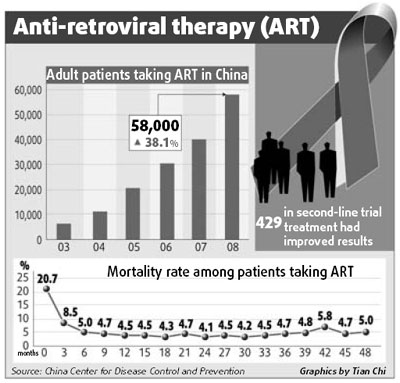
|
CHINA> National
 |
|
Making headway against AIDS
By Qian Yanfeng (China Daily)
Updated: 2009-01-20 07:42
ZHENGZHOU: Significant improvements have been made in controlling HIV/AIDS in Henan province, one of the regions in the country most severely affected by the disease, local authorities have said. The death rate from the disease in Zhumadian city, Henan, has more than halved to 5 percent in the past six years, thanks to consistent and standardized drug treatment, as well as the improvement of patients' living conditions, a local official told China Daily on the sidelines of the 11th provincial people's congress in Henan that concluded last Saturday. "The numbers now are closer to the normal mortality rate and lower than the national average, although we still have a lot to do to combat the disease," said Nie Yong, director of the AIDS/HIV control office of Zhumadian. More than 260,000 people in the country have contracted HIV - the virus that causes AIDS - but about 700,000 Chinese were living with the disease by the end of 2007, including 85,000 AIDS patients, the Ministry of Health said last month on World's AIDS Day. That also means about 440,000 people still do not know they have already contracted the virus, the ministry said. Also, in the first nine months of last year, 44,839 people have been infected with HIV/AIDS, and 6,897 died of the disease. Zhumadian has been notorious for its widespread number of HIV cases for the past decade, following a scandal involving HIV-contaminated blood sales that broke out in the 1990s.
But a combination of anti-viral drug treatment, traditional Chinese medicine and on-the-ground work to help patients cope with the affliction such as the popularization of clinics on the village level has improved the situation, Nie said. "Patients can now enjoy the convenience of seeking medical treatment at local clinics and, with the improvement of their living standard, they have become more optimistic in fighting the disease." Ren Yide, director of the organization department of the Henan Red Cross Society of China, agreed. Ren and his team members have spent the past four years living with AIDS patients in Zhumadian's hardest-hit village of Wenlou. Nearly one-tenth of the 2,000 villagers in Wenlou are known to have contracted the virus. But most of those people are now in good physical and mental condition, Ren said. "Optimism really plays a key role in helping those patients cope with the disease, because they would be more willing to receive treatment," Ren said. Ren said his team members have brought to the patients a new confidence in life, by teaching them ways to stay independent, although the government and other social entities have offered them subsidies. Teaching patients the skills required for animal breeding and the cultivation of quality agricultural products, for instance, has been well received, Ren said. Over the past four years, Ren said he has witnessed a substantial drop in the number of AIDS deaths in the village. About 28 people died of the disease in 2003; while in 2005, that number fell to 13. Last year, five lost their lives to the scourge, he said. Despite the noticeable progress, however, Nie said risks still loom large because the spread of AIDS through sexual transmission - which is "difficult to estimate and control" - has become the major source of HIV infection. Unsafe sex was reportedly practiced by 28 percent of the people afflicted in 2006 to more than 45 percent now. "(Sexual infection) is very difficult to control. We could only address that by promoting education," Nie said.
 (China Daily 01/20/2009 page2) |